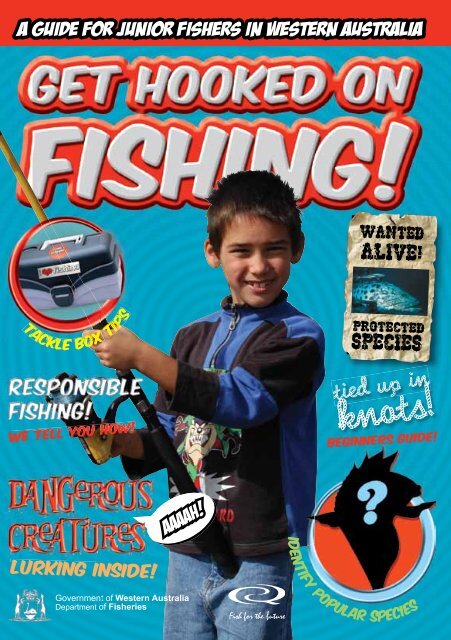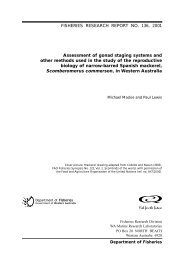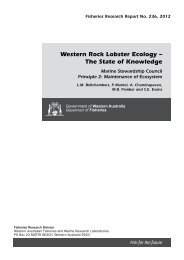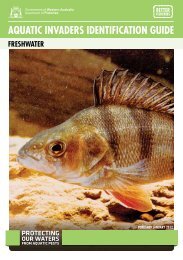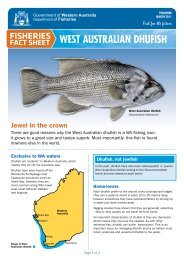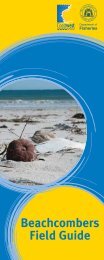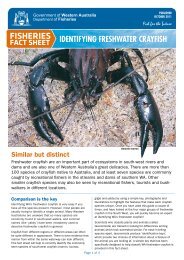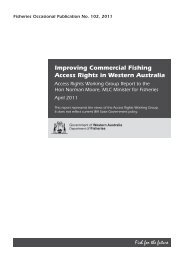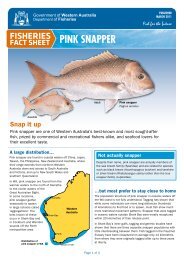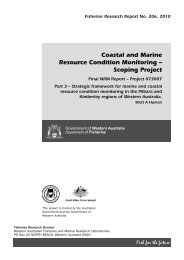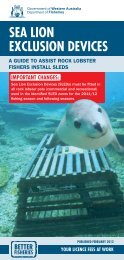Get Hooked on Fishing - Department of Fisheries
Get Hooked on Fishing - Department of Fisheries
Get Hooked on Fishing - Department of Fisheries
You also want an ePaper? Increase the reach of your titles
YUMPU automatically turns print PDFs into web optimized ePapers that Google loves.
A guide for junior Fishers in Western Australia<br />
tackle box tips<br />
k<br />
taaa<br />
tt c<br />
cc l<br />
kk e<br />
l b boo<br />
oo tii<br />
bbbx<br />
iiii s<br />
pp<br />
tttt ppp<br />
we we we tell tell tell yo youu yo youu you how! how! ho howw!! how!<br />
lurking lurkin lurkin<br />
inside!<br />
aaaah!<br />
WANTED<br />
ALIVE!<br />
protected<br />
species<br />
tied up in<br />
knots!<br />
beginners guide!<br />
identify popular species<br />
1
hat’s inside?<br />
3<br />
CARING FOR YOUR CATCH! PAGE THREE<br />
4<br />
GROOVY TACKLE BOX TIPS ON PAGE 4<br />
GET TIED UP IN KNOTS ON PAGE 5!<br />
RESPONSIBLE FISHING -<br />
FIND OUT HOW ON PAGE SIX!<br />
5<br />
SIX<br />
8<br />
WATCH OUT!<br />
DANGEROUS CREATURES LURKING ON PAGE 8<br />
TOTALLY PROTECTED SPECIES ON PAGE 10 -<br />
HANDS OFF!<br />
12 ten<br />
CHECK OUT SOME POPULAR SPECIES ON PAGE 12
Remember!<br />
You <strong>on</strong>ly need<br />
enough for a feed.<br />
Please take care <strong>of</strong> the fish you catch. Release undersize and unwanted<br />
fish quickly and carefully back into the water.<br />
Measuring fish<br />
Touch fish <strong>on</strong>ly with wet hands or a wet rag to avoid damaging the<br />
scales or the fish’s protective slime coating. Gently lay the fish <strong>on</strong><br />
a smooth, wet surface or foam rubber landing pad and measure the<br />
length from its nose to the tip <strong>of</strong> its tail. Fish rulers and brochures<br />
<strong>on</strong> fish size and bag limits are available free <strong>of</strong> charge from your<br />
nearest <strong>Department</strong> <strong>of</strong> <strong>Fisheries</strong> <strong>of</strong>fice.<br />
• Treating the fish gently and not damaging or removing its<br />
protective coating will improve its chances <strong>of</strong> survival after<br />
being released back into the water.<br />
• Gently remove hooks with l<strong>on</strong>g-nosed pliers or a hook extractor.<br />
• If the hook is stuck in the fish’s gills or deep in its gut, cut the line 20 to 30 cm<br />
from the hook and let the fish go. Cutting the line close to the fish’s mouth could<br />
interfere with the fish’s ability to feed. The hook will rust and fall out and the fish<br />
will be able to grow to be caught again when bigger.<br />
• Use a knotless landing net and not a gaff, so you can put the little <strong>on</strong>es back!<br />
Keeping your catch<br />
Remember<br />
to release ALL<br />
undersize fish so they<br />
can grow to become part<br />
<strong>of</strong> the breeding stock and<br />
produce more Fish<br />
for the future!<br />
All fish that are not going to be released should be killed humanely and quickly. The<br />
best way to do this is by ‘iki jimi’ - spiking the fish in the brain with a sharp instrument<br />
just behind the eye. The fish will c<strong>on</strong>vulse, flare its mouth and gills, then suddenly relax.<br />
Another quick and humane method is to cut the fish’s throat and bend the head back to<br />
sever the spine. This approach is better for smaller fish, such as herring and whiting.<br />
Remember!<br />
You <strong>on</strong>ly need<br />
enough for a feed.<br />
Gently place kept fish in an ice slurry (two-parts ice to <strong>on</strong>e-part sea water) in<br />
an esky. If you d<strong>on</strong>’t have an esky keep the fish in a wet hessian, openweave<br />
or cott<strong>on</strong> bag in the shade. Please refer to the <strong>Department</strong> <strong>of</strong><br />
<strong>Fisheries</strong>’ Catch Care brochure or website for further informati<strong>on</strong>.<br />
Remember<br />
3
4<br />
Having the right gear will improve your chances <strong>of</strong> landing your catch<br />
and successfully releasing undersize or excess fish for next time .<br />
4<br />
Hooks ‘n’ stuff - always have an assortment <strong>of</strong> hooks, swivels, sinkers<br />
and floats.<br />
Hooks - barbless hooks, circle hooks and l<strong>on</strong>g-shanked hooks are easier to<br />
remove from a fish’s mouth and reduce injury to the fish. Treble hooks are not<br />
recommended. They cause a lot <strong>of</strong> damage to a fish’s mouth and reduce the<br />
chance <strong>of</strong> undersize fish surviving when returned to the water. Buy barbless<br />
hooks from tackle shops or modify any barbed hooks you may have by crimping<br />
them with a pair <strong>of</strong> pliers, crushing the barb.<br />
<strong>Fishing</strong> line - 6-8 kg breaking strain or less is suitable for most types <strong>of</strong><br />
beach, rock or jetty fishing.<br />
L<strong>on</strong>g-nose pliers - help to remove hooks from the fish’s mouth with as little<br />
damage as possible. They do a similar job to a hook extractor (available from<br />
tackle shops).<br />
Wire cutters - important for safety as they can be used to cut the barbs <strong>of</strong>f<br />
hooks when necessary.<br />
Nail cutters or scissors - an easy way to cut fishing line.<br />
Here’s a check list for your tackle box!<br />
Knife with cover - for cutting up bait. The cover helps keep the blade sharp<br />
and helps protect you from accidental injury.<br />
Cutting board - provides an even surface to cut your bait <strong>on</strong>. Cutting bait <strong>on</strong><br />
hard surfaces such as rocks or c<strong>on</strong>crete will make your knife blunt and damage<br />
the blade.<br />
Hook sharpener - handy to sharpen hooks which have become blunt through use.<br />
Brochures - make sure you have the appropriate regi<strong>on</strong>al Recreati<strong>on</strong>al <strong>Fishing</strong><br />
Guide from the <strong>Department</strong> <strong>of</strong> <strong>Fisheries</strong> and your fish ruler so you know size<br />
and bag limits for your catch.
Top reas<strong>on</strong>s to<br />
tie great knots!<br />
r Makes sure the fish stays <strong>on</strong><br />
the end <strong>of</strong> your line.<br />
r Saves you m<strong>on</strong>ey - you w<strong>on</strong>’t<br />
be losing your fishing gear in the<br />
water.<br />
r Saves the envir<strong>on</strong>ment - fishing<br />
line can be harmful to birds, fish,<br />
dolphins and seals.<br />
Locked half-blood knot<br />
The locked half-blood knot is a simple knot to learn<br />
and can be used for most <strong>of</strong> your fishing needs. Follow<br />
the simple diagram and have a go!<br />
Uni knot or hangman’s knot<br />
More experienced knot tiers may like to try the uni knot or hangman’s knot.<br />
ROTECTED<br />
step 1<br />
SPECIES<br />
step 2<br />
step 3<br />
Knot-tying tips<br />
r Practise using a rope or light<br />
cord until you perfect your knottying<br />
skills.<br />
r Knots should be tied slowly and<br />
steadily and then eased tight.<br />
ROTECTED SPECIES<br />
step 4<br />
r Always wet the knot <strong>on</strong> the<br />
fishing line before pulling it<br />
together.<br />
r Rinse your line in fresh water<br />
after every fishing trip.<br />
5
h h<br />
or small gangs<br />
h<br />
swivel<br />
Resp<strong>on</strong>sible<br />
Fishi<br />
h<br />
b swivel<br />
floath<br />
<strong>Fishing</strong> equipment<br />
In Western Australia, fishers may use no<br />
more than three hooks or gangs <strong>of</strong> hooks per line.<br />
Shore-based fishers may use no more than<br />
two rods or handlines or <strong>on</strong>e <strong>of</strong> each at<br />
the same time.<br />
6<br />
3-way swivel<br />
h<br />
h<br />
h<br />
spo<strong>on</strong> sinker<br />
100cm <strong>of</strong> line<br />
gang hooks to suit bait size<br />
h<br />
size 10 hook<br />
metal ’mulie’ spikeh<br />
� Dress for the weather c<strong>on</strong>diti<strong>on</strong>s.<br />
Pers<strong>on</strong>al safety<br />
It is important to look after<br />
yourself as well as your equipment<br />
when you go fishing.<br />
Take the following tips - they’ll help<br />
make your trip a lot more fun!<br />
� Avoid being out between 10 am and 3 pm to reduce the risk <strong>of</strong><br />
sunburn and skin cancer. A l<strong>on</strong>g-sleeved shirt and l<strong>on</strong>g pants<br />
will protect you from the sun’s harmful rays.<br />
� Use a good sunscreen and remember to reapply it as directed<br />
<strong>on</strong> the c<strong>on</strong>tainer.<br />
� Always wear shoes (preferably enclosed, like runners) to<br />
protect your feet.<br />
� Wear a hat (a broad-brimmed hat or legi<strong>on</strong>naire-style cap is<br />
best) and sunglasses.<br />
� Take some water and a snack to eat.<br />
h<br />
� Always fish with a friend, and tell some<strong>on</strong>e where you are going<br />
fishing and what time to expect you home.<br />
� Check the weather forecast and watch out for unexpected<br />
changes.<br />
� Have a plan for what you would do in case <strong>of</strong> an emergency.<br />
slip<br />
slop<br />
slap!
ng<br />
Caring for your envir<strong>on</strong>ment<br />
c When walking through sand dunes or river vegetati<strong>on</strong><br />
always use the paths provided.<br />
c Always put your rubbish in the bin.<br />
<strong>Fishing</strong> from rocks<br />
c It is important that you know how to swim before you fish<br />
from rocks.<br />
c Always fish with a friend.<br />
c It is easy to get washed in so avoid wet rocks, narrow ledges,<br />
rocks that slope towards the water, and steep and slippery surfaces.<br />
c Look carefully at your fishing spot. Watch it for 15 minutes and if the<br />
rocks you were thinking <strong>of</strong> fishing from get covered with water spray, choose<br />
another place!<br />
c Have a flotati<strong>on</strong> device <strong>on</strong> hand that can be thrown to some<strong>on</strong>e in trouble in the water.<br />
Even a capped, empty two-litre s<strong>of</strong>t drink bottle can be used in an emergency.<br />
c Never turn your back <strong>on</strong> the sea and be aware <strong>of</strong> what’s happening<br />
around you - c<strong>on</strong>diti<strong>on</strong>s can change unexpectedly with the tide.<br />
c Remember, d<strong>on</strong>’t take unnecessary risks - your life is<br />
worth more than a fish or snagged tackle!<br />
c Plastic bait bags floating in the water can be deadly to marine<br />
animals, which mistake them for jellyfish and eat them.<br />
c Discarded fishing line can get tangled around seabirds’ legs or other<br />
marine life.<br />
c When fishing by boat, drop your anchor in clear sand patches<br />
to avoid damaging the seagrass and reefs.<br />
c Do not feed marine life such as dolphins, seals and seabirds<br />
because they may start to rely <strong>on</strong> us for food and this<br />
will interfere with their natural behaviour.<br />
7
8<br />
LIONFISH<br />
dangerous<br />
Animals have developed feeding and defence mechanisms to help them<br />
survive in their natural habitats. We need to be aware <strong>of</strong> these to<br />
avoid being accidentally injured.<br />
animals with spines<br />
Fish with spines include stingrays, cobbler (or catfish), flathead, st<strong>on</strong>efish,<br />
scorpi<strong>on</strong>cod, li<strong>on</strong>fish and Port Jacks<strong>on</strong> shark. The spines c<strong>on</strong>tain venom,<br />
which is released <strong>on</strong> c<strong>on</strong>tact with the skin. This venom may cause extreme<br />
pain, depending <strong>on</strong> the size <strong>of</strong> the fish and the amount <strong>of</strong> venom injected.<br />
Handle the fish carefully to avoid the fins and gills where spines may<br />
be located. Some stingrays have a barb at the base <strong>of</strong> the tail, which is<br />
highly mobile and can inflict a harmful injury. If you do hook a stingray,<br />
cut the line near the fish’s mouth rather than trying to remove the hook<br />
- but be careful <strong>of</strong> the tail.<br />
first aid for venomous spines<br />
1. Remove the patient from the water.<br />
2. Apply pressure to the wound to stop bleeding.<br />
3. Immerse the wounded limb in hot water (be careful not to burn the skin).<br />
4. Immobilise the limb and cover with a clean dressing.<br />
5. Send for an ambulance/medical help.<br />
animals that bite<br />
Be aware that many fish have sharp teeth and that some marine<br />
animals will bite if they feel threatened. If you get bitten, apply<br />
pressure to the wounded area to stop bleeding. It may be<br />
Blue-RINGED OCTOPUS<br />
Bluebot
tle<br />
creatures<br />
necessary to seek medical aid. Some animals can be potentially deadly to humans,<br />
including the c<strong>on</strong>e shell, blue-ringed octopus and sea snakes. Leave them well<br />
al<strong>on</strong>e.<br />
animals that sting<br />
Jellyfish are the most comm<strong>on</strong> stinger encountered at the beach. Corals and<br />
anem<strong>on</strong>es also have stinging cells, which can inflict a painful sting to humans.<br />
For jellyfish stings where there is minimal pain, apply a cold compress. Vinegar is not<br />
appropriate for some species, particularly the bluebottle (Portuguese man-o-war).<br />
Do not put water <strong>on</strong> any jellyfish sting, as it could set <strong>of</strong>f undischarged stings.<br />
If stung by a box jellyfish, remove the patient from the sea, being careful to avoid c<strong>on</strong>tact<br />
with further tentacles. Flood the stung area with vinegar to neutralise stinging<br />
cells, and seek urgent medical aid.<br />
animals that are<br />
pois<strong>on</strong>ous to eat<br />
Puffer fish, including northwest blowfish,<br />
toadfish and porcupine fish - including the<br />
comm<strong>on</strong> “blowie” - are pois<strong>on</strong>ous to eat. They<br />
c<strong>on</strong>tain a str<strong>on</strong>g toxin which attacks the nervous<br />
system, resulting in paralysis and the inability<br />
to see, swallow or speak. However, the victim may<br />
remain c<strong>on</strong>scious! Seek URGENT medical aid. Expired air<br />
resuscitati<strong>on</strong> (EAR) may be necessary.<br />
STINGRAY<br />
9
WANTED<br />
ALIVE!<br />
potato<br />
cod<br />
WANTED<br />
ALIVE!<br />
GREAT WHITE<br />
SHARK<br />
10<br />
PROTECTED<br />
In Western Australia, fish are protected by fishing rules<br />
and regulati<strong>on</strong>s, including bag and size limits, to ensure<br />
PROTECTED<br />
there will be fish for the future. The excepti<strong>on</strong>s are<br />
bait fish (pilchards, scaly mackerel, whitebait,<br />
anchovies and hardyheads) and feral freshwater<br />
species like carp, tilapia, goldfish and redfin perch.<br />
For bag and size limit informati<strong>on</strong> go to www.fish.wa.gov.au<br />
or pick up a regi<strong>on</strong>al Recreati<strong>on</strong>al <strong>Fishing</strong> Guide at your<br />
nearest <strong>Department</strong> <strong>of</strong> <strong>Fisheries</strong>’ <strong>of</strong>fice.<br />
Some fish are totally protected because they are low<br />
in number, are under threat from overfishing or are highly<br />
valued by the marine tourism industry. If caught, they<br />
must be returned immediately to the water.<br />
WANTED<br />
ALIVE!<br />
LEAFY SEA<br />
DRAGON<br />
WANT<br />
ALIV<br />
humph<br />
mao<br />
wras
ED<br />
E!<br />
ead<br />
ri<br />
se<br />
SPECIES<br />
The following species are totally protected<br />
in Western Australia and may not be taken:<br />
SPECIES<br />
Potato cod (Epinephelus tukula)<br />
Humphead maori wrasse (Cheilinus undulatus)<br />
Leafy seadrag<strong>on</strong> (Phycodurus eques)<br />
Whale shark (Rhiniod<strong>on</strong> typus)<br />
Great white shark (Carcharod<strong>on</strong> carcharias)<br />
Grey nurse shark (Carcharias taurus)<br />
Coral (Order Sceractinia)<br />
WANTED<br />
ALIVE!<br />
coral<br />
WANTED<br />
ALIVE!<br />
grey nurse<br />
shark<br />
WANTED<br />
ALIVE!<br />
whale<br />
shark<br />
11
12<br />
whiting<br />
australian herring<br />
Some<br />
h<br />
Popul<br />
swivel skipjack h trevally<br />
Tailor<br />
tarwhine<br />
running ball sinkerh<br />
Other names: Choppers (small fish below <strong>on</strong>e kg) and jumbos (more<br />
100cm <strong>of</strong> line<br />
than 3 kg).<br />
h<br />
Scientific name: Pomatomus saltatrix.<br />
Berley blob swivel<br />
Distributi<strong>on</strong>: In WA, from Wils<strong>on</strong> Inlet to Coral Bay.<br />
floath<br />
australian salm<strong>on</strong><br />
Habitat: Tailor generally live in rivers and estuaries in summer and<br />
move to the ocean in winter.<br />
squid<br />
h<br />
Recommended bait: Mulies, whitebait and sardines.<br />
Recommended rigs: In sandy bottom c<strong>on</strong>diti<strong>on</strong>s, use a Paternoster<br />
rig – the sinker is tied to the end <strong>of</strong> the line and a separate line with a<br />
gang <strong>of</strong> hooks is attached above the sinker (see below). When casting<br />
over reef use a bait-casting rig – the gang (hooks) is simply attached to<br />
a 600 mm trace and swivel. Popper lures and metal spinners can also be<br />
used for tailor.<br />
blue swimmer crab<br />
3-way swivelh<br />
h<br />
spo<strong>on</strong> sinkerh<br />
h<br />
h<br />
gang hooks to suit bait size<br />
50cm <strong>of</strong> line<br />
size 6 hook<br />
or small gangs<br />
size 10 hook
australian herring<br />
skipjack trevally<br />
Tailor<br />
tarwhine<br />
australian salm<strong>on</strong><br />
Other name: Silver bream.<br />
ar Species<br />
whiting<br />
squid<br />
Scientific name: Rhabdosargus sarba.<br />
Distributi<strong>on</strong>: Esperance to Shark Bay.<br />
Habitat: Coastal marine and estuaries,<br />
occasi<strong>on</strong>ally <strong>of</strong>fshore reefs (to 35 metres deep).<br />
g Recommended bait: Squid, prawns and worms.<br />
australian herring<br />
blue swimmer crab<br />
lian herring<br />
skipjack trevally<br />
ck Tailor trevally<br />
Other names: Skippy and silver trevally.<br />
tarwhine<br />
Scientific name: Pseudocaranx dentex.<br />
ine Habitat: Coastal waters, <strong>of</strong>ten enters estuaries.<br />
australian salm<strong>on</strong><br />
Recommended bait: Whitebait and prawn.<br />
alian<br />
squid<br />
salm<strong>on</strong><br />
Recommended rig: Running sinker rig (see whiting).<br />
Distributi<strong>on</strong>: Southern Australia to North West Cape in WA.<br />
Recommended rig: Running sinker rig (see whiting).<br />
<strong>Fishing</strong> tips: Best targeted from February to May.<br />
blue swimmer crab<br />
13
14<br />
whiting<br />
australian herring<br />
Other names: Tommy rough, ruffie and sea herring.<br />
skipjack trevally<br />
Tailor<br />
tarwhine<br />
Scientific name: Arripis georgianus.<br />
Distributi<strong>on</strong>: Southern Australia to Shark Bay in WA.<br />
Very comm<strong>on</strong> at Rottnest Island.<br />
Habitat: Usually caught close to reefs al<strong>on</strong>g the<br />
coast or in estuaries.<br />
Recommended bait: Whitebait, prawn, squid<br />
and maggots.<br />
Recommended rig: Berley blob float rig – the<br />
berley blob allows the bait to float near the<br />
surface <strong>of</strong> the water while the berley attracts<br />
swivel<br />
the fish hto<br />
the bait. Other hfish<br />
caught <strong>on</strong> this<br />
rig include garfish.<br />
australian salm<strong>on</strong><br />
running ball sinkerh<br />
squid<br />
h<br />
h<br />
swivel<br />
blue swimmer crab<br />
Berley blob floath<br />
IMPORTANT!<br />
The Australian herring looks<br />
similar to a juvenile Western<br />
Australian salm<strong>on</strong>. The<br />
difference is that the salm<strong>on</strong><br />
has smaller eyes and lacks the<br />
black dots <strong>on</strong> the end <strong>of</strong> the<br />
h<br />
h<br />
50cm <strong>of</strong> line<br />
caudal fin (tail).<br />
size 6 hook<br />
or small gangs<br />
100cm <strong>of</strong> line<br />
size 10 hook
australian herring<br />
skipjack trevally<br />
swivel h h<br />
Tailor<br />
tarwhine<br />
running ball sinkerh<br />
australian h<br />
swivelh<br />
salm<strong>on</strong><br />
Berley blob floath<br />
Other names: Salm<strong>on</strong>, kahawai and salm<strong>on</strong> trout.<br />
squid<br />
Scientific name: Arripis truttaceus<br />
Distributi<strong>on</strong>: Kalbarri in WA (rare north <strong>of</strong> Perth) to Victoria.<br />
blue swimmer crab<br />
Habitat: Estuaries and coastal waters generally adjacent to rocky<br />
shorelines.<br />
Recommended bait: Pilchard and whitebait.<br />
Recommended rig: Bottom rig for beach fishing (see below), floating<br />
rig for use around reefs, bait casting and popper lures.<br />
h<br />
<strong>Fishing</strong> tips: Best 3-way swivel targeted from February to May.<br />
3-way swivelh<br />
h<br />
spo<strong>on</strong> sinkerh<br />
h<br />
gang hooks to suit bait size<br />
snap swivelh<br />
h<br />
triple ganged hooks<br />
50cm <strong>of</strong> line<br />
size 6 hook<br />
or small gangs<br />
100cm <strong>of</strong> line<br />
size 10 hook<br />
h<br />
spo<strong>on</strong> sinker<br />
15
16<br />
western school whiting<br />
sand whiting<br />
yellowfin whiting<br />
run
whiting<br />
Other names: There are 13 species <strong>of</strong> whiting in Australian waters,<br />
with various names!<br />
australian herring<br />
Scientific name: Sillaginodes spp.<br />
Important: How do you tell the difference between King George whiting<br />
(Sillaginodes punctata) and the other 12 species? The King George<br />
whiting has distinctive small brown spots <strong>on</strong> its sides.<br />
skipjack trevally<br />
Tailor<br />
tarwhine<br />
Distributi<strong>on</strong>: Southern Australia to Lancelin in WA.<br />
Habitat: Coastal sandy bottoms or around <strong>of</strong>fshore reefs and estuaries.<br />
Recommended bait: Prawns, squid and mussels.<br />
Recommended rig: Running sinker rig – the line is threaded through<br />
the sinker rather than being tied to it, enabling you to feel fish that are<br />
timid biters. Other fish also caught <strong>on</strong> this rig include skipjack trevally,<br />
bream, flathead and flounder.<br />
australian salm<strong>on</strong><br />
h<br />
h<br />
ning ball<br />
swivel<br />
sinkerh<br />
squid<br />
king george whiting<br />
h<br />
h<br />
50cm <strong>of</strong> line<br />
size 6 hook<br />
or small gangs<br />
100cm <strong>of</strong> line<br />
17
-way swivel<br />
h<br />
18<br />
australian herring<br />
skipjack trevally<br />
Tailor<br />
tarwhine<br />
australian h<br />
spo<strong>on</strong> sinker salm<strong>on</strong><br />
squid<br />
Other name: Southern calamari<br />
blue swimmer crab<br />
hScientific name: Sepioteuthis triple australis ganged hooks<br />
spo<strong>on</strong> sinker<br />
way swivel Distributi<strong>on</strong>: South from Dampier, in WA.<br />
Habitat: Inshore marine and estuarine areas, including seagrass beds<br />
and exposed sand.<br />
h<br />
Recommended rig: Squid jig (plastic prawn or metal ‘mulie’ spike – no<br />
bait is used). snap swivel<br />
<strong>Fishing</strong> tips: Cast jig and let it sink almost to the bottom. Wind in line<br />
with a jerking moti<strong>on</strong>, pausing between each jerk. When you hook a<br />
squid, try to allow it to dispel its ink before bringing it ashore. The best<br />
time for squid fishing is early morning or evenings. Squid can be caught<br />
all year round but the peak time is from April to September.<br />
h<br />
gang hooks to suit bait size<br />
metal ’mulie’ spikeh<br />
h
skipjack trevally<br />
Tailor<br />
tarwhine<br />
australian salm<strong>on</strong><br />
squid<br />
blue swimmer crab<br />
Other names: Blue manna crab and sand crab.<br />
Scientific name: Portunus pelagicus.<br />
Distributi<strong>on</strong>: From Augusta to Dampier, in WA.<br />
Habitat: Estuarine and inshore waters.<br />
Recommended bait: Fish skelet<strong>on</strong>s and scraps or meat and b<strong>on</strong>e<br />
scraps.<br />
Recommended rig: Scoop nets or drop nets.<br />
<strong>Fishing</strong> tips: Best fishing times are late afterno<strong>on</strong>, evening and early<br />
morning. Crabs can be caught all year round but peak between January<br />
and May. Estuaries are best targeted for crabs in late summer and<br />
autumn, and oceanic waters in winter and spring.<br />
19
20<br />
A guide for junior Fishers in Western Australia<br />
OFFICIAL STUFF!<br />
This publicati<strong>on</strong> is copyright (<strong>Department</strong> <strong>of</strong> <strong>Fisheries</strong> 2005).<br />
Apart from any use under the Copyright Act 1968 (Cwth), no<br />
part <strong>of</strong> this publicati<strong>on</strong> may be reproduced by any process, or<br />
any other exclusive right exercised, without the specific written<br />
permissi<strong>on</strong> <strong>of</strong> the <strong>Department</strong> <strong>of</strong> <strong>Fisheries</strong>.<br />
For more informati<strong>on</strong> ...<br />
C<strong>on</strong>tact the <strong>Department</strong> <strong>of</strong> <strong>Fisheries</strong> Head Office:<br />
Level 3, The Atrium<br />
168 St Georges Tce, Perth 6000<br />
Ph: (08) 9482 7333<br />
Fax: (08) 9482 7389<br />
or check out our AWESOME website at<br />
www.fish.wa.gov.au<br />
RS034<br />
August 2005


